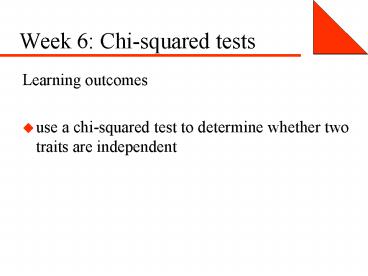Week 6: Chi-squared tests - PowerPoint PPT Presentation
Title:
Week 6: Chi-squared tests
Description:
... from this survey that drinking habits are related to the age of the drinker. ... few heavy drinkers in the oldest age group and fewer than expected in the 45 to ... – PowerPoint PPT presentation
Number of Views:36
Avg rating:3.0/5.0
Title: Week 6: Chi-squared tests
1
Week 6 Chi-squared tests
- Learning outcomes
- use a chi-squared test to determine whether two
traits are independent
2
Frequency table
3
Contingency table 2 way
4
Contingency table 2 way
5
Question
- Are the proportions of males having each of the
qualifications the same as the corresponding
proportions for females? - Males 15 A-level, 61 higher, 24 other
- Females 17, 62, 21
- Are qualifications independent of gender?
- For this example the answer is yes.
6
Mendels peas experiment
7
Chi-squared test for independence
- Null hypothesis the attribute smooth or
wrinkled is independent of whether the pea is
green or yellow. - Alternative hypothesis the proportion which are
smooth depends on the colour of the pea.
8
Expected frequencies
- If the null hypothesis is true then the
proportion of smooth peas is - 423/556
- regardless of the colour of the pea
9
Expected number green and smooth
Therefore the expected number green and smooth is
this proportion of the number of green peas
10
In the same way
Yellow and smooth
Green and wrinkled
Green and smooth
11
Observed/Expected frequencies
12
Observed/Expected frequencies
13
Formula
- The expected values in each row and column add up
to the corresponding marginal total. - Therefore, in a 2x2 table, once one expected
value is calculated the rest can be obtained by
subtraction. - A 2x2 contingency table as 1 degree of freedom.
14
Chi-squared test for a 2x2 table
To compare the observed and expected frequencies
- follows a chi-squared distribution with 1 degree
of freedom.
15
Peas example
16
conclusion
- Since the value of chi-squared is low
- observed frequencies are close to expected
frequencies - the null hypothesis can be accepted
- there is no evidence of an association between
colour and texture
17
Using tables
- Using a 5 significance level with 1 degree of
freedom the null hypothesis would be rejected if
18
Note
- The chi-squared test is only valid if the
expected frequencies are greater than 5. - The degrees of freedom for a table with r rows
and c columns are - (r - 1) x ( c - 1)
19
Age and drinking categories of a sample of males
20
Expected frequencies
21
Chi-squared statistic
- Degrees of freedom (3 - 1) x (5 - 1) 8
- Value from tables for a 5 significance level is
15.51.
22
Conclusions
- The value of chi-squared is large therefore
- There is very convincing evidence from this
survey that drinking habits are related to the
age of the drinker. - A comparison of the observed values with the
expected values in the table shows that there are
very few heavy drinkers in the oldest age group
and fewer than expected in the 45 to 54 years age
group.
23
SPSS
- The original form of the data will be a row for
each individual e.g. - Units Age
- 1 4
- 2 3
- 1 1
- SPSS does two things
- Creates the contingency table
- Carries out a chi-squared test on the table.
24
AnalysegtDescriptive StatisticsgtCrosstabs
Select Statistics and Chi-square Select Cells
and Expected
25
Contingency Table
26
Chi-squared test
27
Goodness of fit tests
28
Expected frequencies
29
Chi-squared test
- follows a chi-squared distribution with d.f.
- number of categories - 1
30
Result
- Since chi-squared is small (lt the appropriate
value from the tables with 3 degrees of freedom)
the theoretical model is a good fit to the data.

